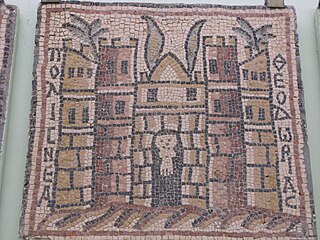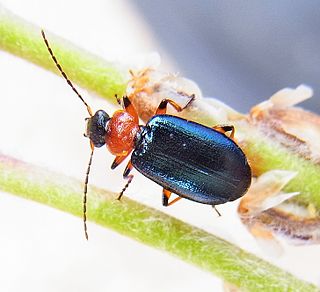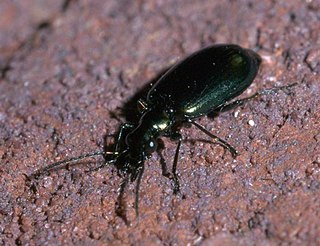Related Research Articles

Olbia or Theodorias was a Roman / Byzantine town between Marj and Bayda in the Cyrenaica region of modern Libya. Olbia is now mostly the archaeological site. The location's modern name is Qasr Libya, after the Islamic period castle (Qasr) on the site and Libya or Lebia as a corruption of the ancient name Olbia.

Lebia is a genus of predatory ground beetles. Common names include colorful foliage ground beetles and flat ground beetles. They are found worldwide and there over 700 species in 17 subgenera.

Lebia grandis is a ground beetle in the family Carabidae found in North America. It is a specialist predator on the eggs and larvae of Colorado potato beetles, and its larvae are obligate parasitoids of Colorado potato beetle pupae.

Lebia cyanocephala, sometimes called the blue plunderer, is a ground beetle from a subfamily of Harpalinae.
Lebia turkestanica is a species of ground beetles in the Harpalinae subfamily that can be found in southern part of Russia and Ukraine.
Lebia trimaculata is a species of ground beetles in the Harpalinae subfamily that can be found in Austria, Bulgaria, Croatia, Cyprus, France, Greece, Hungary, Italy, Moldova, North Macedonia, Portugal, Romania, Russia, Slovakia, Switzerland, and Ukraine.
Lebia maraniana is a species of ground beetles in the Harpalinae subfamily that is endemic to Spain.
Lebia menetriesi is a species of ground beetles in the Harpalinae subfamily that can be found in Ukraine and southern part of Russia.

Lebia marginata is a species of ground beetles in the Harpalinae subfamily that can be found in Austria, Belgium, Bulgaria, Czech Republic, Germany, Great Britain, Hungary, Italy, Liechtenstein, Luxembourg, Poland, Romania, Slovakia, Switzerland, Ukraine, Yugoslavian states, everywhere in Western Europe, and southern part of Russia.
The iridescent toothcarp is a species of killifish. It can be found in Western Asia. It occurs in a wide range of freshwater habitats. It grows to 5 cm (2.0 in) total length. This species was described in 1843 as Lebias mento by Johann Jakob Heckel with the type locality given as Mosul in Iraq.

Lebia ornata is a species of ground beetle in the genus Lebia, in the family Carabidae. It was described by American entomologist Thomas Say in 1823.

Lebia viridis is a species of predatory ground beetle in the family Carabidae. It is found in North America, Guatemala, Mexico and on Cuba. It measure 5 to 7 mm. Diurnal; can sometimes be very common on flowers and vegetation.

Lebia lobulata is a species of ground beetle in the family Carabidae. It is found in North America.
Lebia arizonica is a species of ground beetle in the family Carabidae. It is found in North America.

Lebia tricolor is a species of ground beetle in the family Carabidae. It is found in North America.

Lebia viridipennis, the green-winged lebia, is a species of ground beetle in the family Carabidae. It is found in North America.
Lebia tuckeri is a species of ground beetle in the family Carabidae. It is found in North America.

Lebia vittata is a species of ground beetle in the family Carabidae. It is found in North America.
Lebia marginicollis is a species of ground beetle in the family Carabidae. It is found in North America.
Lebia cyanipennis is a species of ground beetle in the family Carabidae. It is found in North America.
References
- ↑ "Lebia holomera Chaudoir, 1871". 2.6.2. Fauna Europaea. August 29, 2013. Archived from the original on January 7, 2014. Retrieved January 7, 2014.